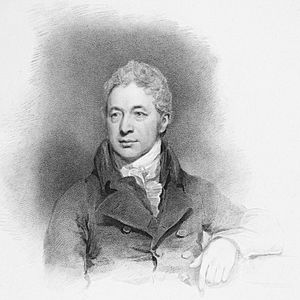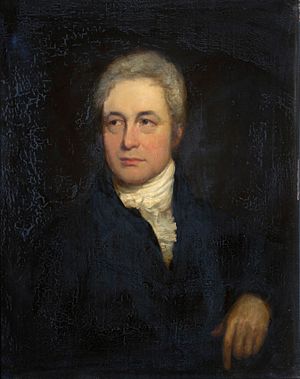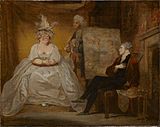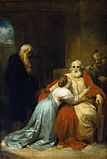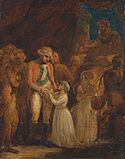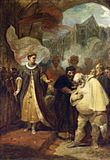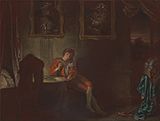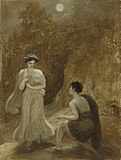Robert Smirke (painter) facts for kids
Robert Smirke was an English painter and illustrator. He was born in 1753 and lived until 1845. He was known for his small paintings that often showed scenes from famous books. Robert Smirke was also a member of the important Royal Academy of Arts.
Contents
Early Life and Art Training
Smirke was born in a place called Wigton, near Carlisle. His father was an artist who traveled a lot. When Robert was just twelve years old, he became an apprentice in London. This meant he worked for a painter who created designs for coats of arms.
When he turned twenty, Smirke began to study art more seriously. He joined the Royal Academy Schools. This was a special art school where he could learn from top artists.
Becoming a Recognized Artist
In 1775, Smirke joined the Incorporated Society of Artists. He started showing his paintings there. He displayed five works in his first exhibition. He also showed his art in 1777 and 1778.
Later, in 1786, he showed two paintings at the Royal Academy. These were called Narcissus and The Lady and Sabrina. The second painting was inspired by a story from Milton's famous play, Comus. After this, he created many more small paintings. These often illustrated stories from English poets, like James Thomson.
In 1791, Smirke became an "associate" of the Royal Academy. This was a step towards becoming a full member. That same year, he showed a painting called "The Widow." He became a full member, known as an "academician," in 1793. For this, he painted a special artwork called Don Quixote and Sancho.
His last painting shown at the Royal Academy was Infancy in 1813. However, he continued to show his art at other places until 1834.
Challenges and Family Life
In 1804, Smirke was suggested for a job as "keeper" at the Royal Academy. This job involved looking after the art and students. However, King George III did not approve. The King was concerned about Smirke's political ideas. Because of this, another artist, Henry Fuseli, got the job instead.
Around 1815, a group called the British Institution caused some upset. They published a book about old paintings. This book suggested that British artists needed to learn a lot from older, foreign masters. Many artists felt this was unfair. Robert Smirke is believed to have written some funny, mocking articles in response. These articles made fun of important people in the art world.
Robert Smirke had several talented sons. Richard Smirke became an artist who studied old things. Robert and Sydney both became famous architects. They also became members of the Royal Academy. His fourth son, Edward, was a well-known lawyer and expert on old history.
Robert Smirke passed away on January 5, 1845. He was 92 years old. He was buried in Kensal Green Cemetery in London.
Robert Smirke's Artworks
Smirke's paintings were usually small. They were often painted in "monochrome," meaning they used different shades of one color, like black and white. This made them perfect for engraving. Engraving is a way of making prints from a picture.
Illustrations for Books
Smirke designed pictures for many books, including:
- The Bible
- The Picturesque Beauties of Shakespeare (1783)
- Johnson's Rasselas (1805)
- Gil Blas (1809)
- The Arabian Nights (1811)
- Adventures of Hunchback (1814)
- Don Quixote (translated by his daughter, Mary Smirke, in 1818)
- Works by various British poets, especially James Thomson.
Some of his well-known illustrations include The Pedagogue, The Rivals, The Secret, and The Love Letter. These were often made into prints for popular books and magazines.
Other Notable Paintings
Smirke also painted pictures for important art projects. He created several works for John Boydell's Shakespeare Gallery. This gallery showed paintings inspired by Shakespeare's plays. His works for this project included:
- Katharine and Petruchio
- Juliet and the Nurse
- Prince Henry and Falstaff
- The Seven Ages (a series of paintings showing different stages of life).
He also painted for Bowyer's History of England. One large print, showing fifteen portraits, was made from his design of The Victory of the Nile. This celebrated a famous naval battle.
In the Guildhall Art Gallery in London, you can find some of his paintings. These include Conjugal Affection, or Industry and Prudence, and a series of scenes from Don Quixote.
Gallery
-
Scene from Samuel Foote's play "Taste", late 1700s.
-
The Awakening of King Lear, around 1792.
-
Falstaff rebuked, around 1795.
-
From the series The Seven Ages of Man, The Lover, from As You Like It, between 1798 and 1801.
-
Lysander declaring his passion to Helena, around 1820–1825.


